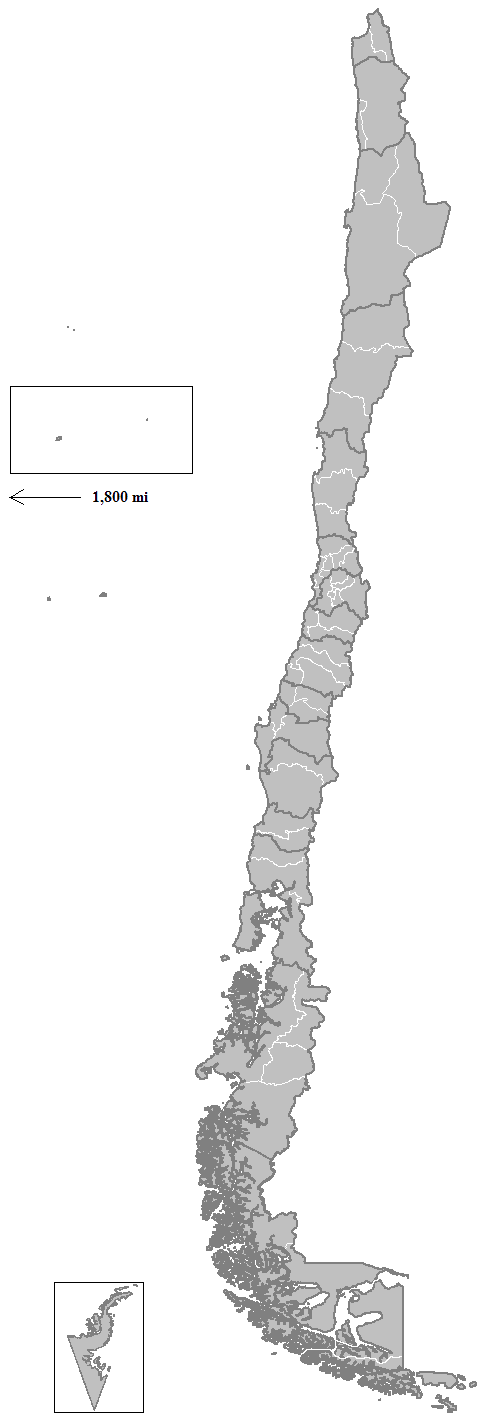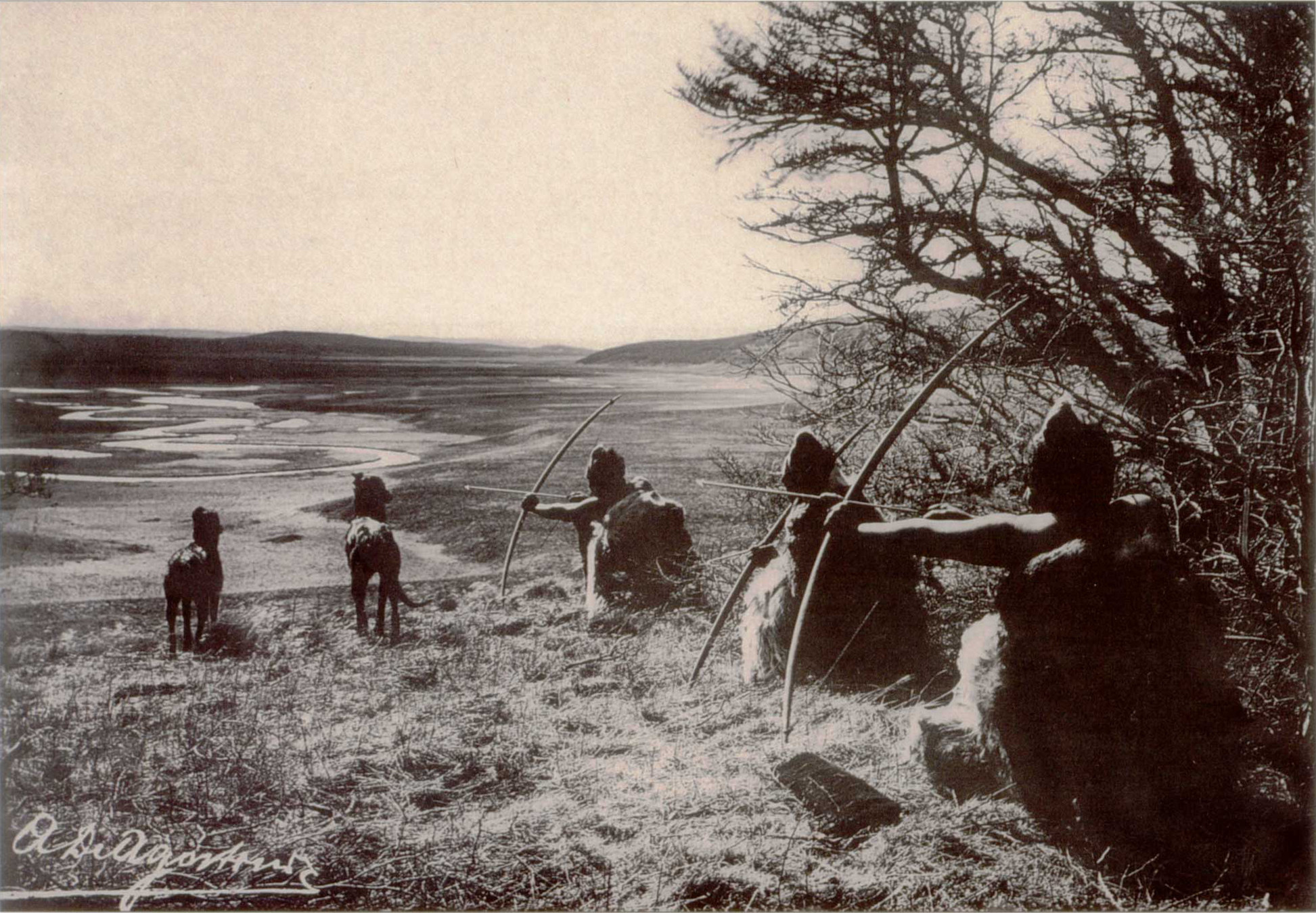|
Tierra Del Fuego Province, Chile
Tierra del Fuego Province () is one of four provinces in the southern Chilean region of Magallanes and Antártica Chilena (XII). It includes the Chilean or western part of the main island of Tierra del Fuego, except for the part south of the Cordillera Darwin, which is in Antártica Chilena Province. Chilean Tierra del Fuego has two towns, Porvenir, capital of the province, and Cerro Sombrero, and a number of small villages. A key geographical feature is Bahía Inútil ("Useless Bay"), so named by British geographers in the late 19th century because the bay is not useful as a port. Geology and hydrography Gold-bearing sands have been recorded at a number of sites within the Fuegan shores of the Tierra del Fuego Province. Chilean Tierra del Fuego is known for numerous small lakes, including Lago Blanco and Lago Deseado. The climate is Subpolar Oceanic, bordering on a Tundra climate. Demography According to the 2002 census by the National Statistics Institute (''INE''), th ... [...More Info...] [...Related Items...] OR: [Wikipedia] [Google] [Baidu] |
Provinces Of Chile
A province is a second-level administrative division in Chile. There are 56 in total. The top-level administrative division in Chile is the regions of Chile, region. There are 16 in total. Each provincial presidential delegation (''delegación presidencial provincial'') is headed by a provincial presidential delegate (''delegado presidencial provincial'') appointed by the President of Chile, President. The governor exercises their powers in accordance with instructions from the regional presidential delegate (''delegado presidencial regional''). The provincial delegate is advised by the Provincial Economic and Social Council (''Consejo Económico y Social Provincial'' or CESPRO). No provincial presidential delegations exist in those provinces where the regional capital is located; its functions were merged with those of the regional presidential delegate. The country's provinces are further divided into 346 communes of Chile, communes which are administered by an alcalde and m ... [...More Info...] [...Related Items...] OR: [Wikipedia] [Google] [Baidu] |
Cerro Sombrero
Cerro Sombrero (Spanish for "Hat Hill") is a village () in southern Chile. It is located in the Primavera commune in the Magallanes Region, in the northern part of Tierra del Fuego, about 125 km from Porvenir. According to the 2002 census, it had 687 inhabitants. The village is located near a small hill from which it received its name. It was founded in 1958 as a residential and services centre for the national Petroleum Company ( ENAP) in Tierra del Fuego, with over 150 dwellings, a gym, swimming pool, bowling alley, botanical garden, movie theatre, church, hospital, warehouses, supermarket, restaurant, lodgings and gas station, in addition to the ENAP offices. This settlement is a natural entry point to the Chilean-Argentine Tierra del Fuego area. Nearby is Bahía Lomas, a place of biotic importance within the region with nesting places for a wide variety of shorebird species, both resident and migratory. Nearby Río del Oro, in the middle of the Tierra del Fuego st ... [...More Info...] [...Related Items...] OR: [Wikipedia] [Google] [Baidu] |
1949 Tierra Del Fuego Earthquake
The 1949 Tierra del Fuego earthquakes occurred slightly more than eight hours apart on 17 December. Their epicenters were located in the east of the Chilean Tierra del Fuego Province, close to the Argentine border on the island of Tierra del Fuego. The two shocks measured 7.7 and 7.6 on the moment magnitude scale and were the most powerful ever recorded in the south of Argentina and one of the most powerful in austral Chile. They were felt with intensities as high as VIII (''Severe'') on the Mercalli intensity scale, and affected the settlements of Punta Arenas and Río Gallegos. See also * List of earthquakes in 1949 * List of earthquakes in Chile * List of earthquakes in Argentina References External links * Instituto Nacional de Prevención Sísmica''Listado de Terremotos Históricos'' * 1949 Events January * January 1 – A United Nations-sponsored ceasefire brings an end to the Indo-Pakistani War of 1947. The war results in a stalemate and the divis ... [...More Info...] [...Related Items...] OR: [Wikipedia] [Google] [Baidu] |
Tierra Del Fuego
Tierra del Fuego (, ; Spanish for "Land of Fire", rarely also Fireland in English) is an archipelago off the southernmost tip of the South America, South American mainland, across the Strait of Magellan. The archipelago consists of the main island, Isla Grande de Tierra del Fuego, with an area of , along with numerous smaller islands, including Cape Horn and Diego Ramírez Islands. The western part of the Tierra del Fuego archipelago, about two-thirds including its many islands, is part of Chile, and the eastern part is part of Argentina. The southernmost extent of the archipelago, Cape Horn, lies just north of latitude 56th parallel south, 56°S. The earliest-known human settlement in Tierra del Fuego dates to approximately 8,000 BC. Europeans first explored the islands during Ferdinand Magellan's expedition of 1520. ''Tierra del Fuego'' ("Land of Fire") and similar names stem from sightings of the many fires that the inhabitants built along the coastline and possibly even in ... [...More Info...] [...Related Items...] OR: [Wikipedia] [Google] [Baidu] |
Tierra Del Fuego Province, Argentina
Tierra del Fuego (Spanish language, Spanish for "''Land of Fire''"; ), officially the Province of Tierra del Fuego, Antarctica and South Atlantic Islands (Spanish language, Spanish: ''Provincia de Tierra del Fuego, Antártida e Islas del Atlántico Sur''), is the southernmost, smallest (without disputed territories), and least populous Provinces of Argentina, Argentine province. The provincial capital city is Ushuaia, from a native word meaning "bay towards the end". The territory of the current province had been inhabited by indigenous people for more than 12,000 years, since they migrated south of the mainland. It was first encountered by a European in 1520 when spotted by Ferdinand Magellan. Even after Argentina achieved independence, this territory remained under indigenous control until the nation's campaign known as the Conquest of the Desert in the 1870s, after which Argentina organised this section in 1885 as a territory. European immigration followed due to Tierra del F ... [...More Info...] [...Related Items...] OR: [Wikipedia] [Google] [Baidu] |
Tierra Del Fuego Gold Rush
Between 1883 and 1906 Tierra del Fuego experienced a gold rush attracting many Chileans, Argentines and Europeans to the archipelago, including many Dalmatians. The gold rush led to the formation of the first towns in the archipelago and fueled economic growth in Punta Arenas. After the gold rush was over, most gold miners left the archipelago, while the remaining settlers engaged in sheep farming and fishing. The rush made a major contribution to the genocide of the indigenous Selkʼnam people. Early discoveries Early attempts to find gold centered in the rivers next to Punta Arenas which drain Brunswick Peninsula to the Strait of Magellan. Small finds occurred in 1869, and in 1870 the governor of Magallanes Óscar Viel sent a 35-gram gold nugget to Chilean president José Joaquín Pérez as a gift. From April 1870 to April 1871 at least 15 kg of gold were mined near Punta Arenas. Most gold ended up in Valparaíso and the ships that engaged in commerce in the increasi ... [...More Info...] [...Related Items...] OR: [Wikipedia] [Google] [Baidu] |
Yaghan People
The Yahgan (also called Yagán, Yaghan, Yámana, Yamana, or Tequenica) are a group of Indigenous peoples in the Southern Cone of South America. Their traditional territory includes the islands south of Isla Grande de Tierra del Fuego, extending their presence into Cape Horn, making them the world's southernmost Indigenous human population. In the 19th century, the Yahgan were known in English as "Fuegians." The name is credited to Captain James Weddell, who supposedly created the term in 1822. The term is now avoided as it can also refer to several other Indigenous peoples of Tierra del Fuego, for example the Selkʼnam. The Yahgan language, also known as Yámana, is considered a language isolate. Cristina Calderón (1928–2022), who was born on Navarino Island, Chile, was known as the last full-blooded Yahgan and last native speaker of the Yahgan language. It is now regarded as an extinct language. Most Yahgan now speak Spanish. The Yahgan were traditionally nomads and hunt ... [...More Info...] [...Related Items...] OR: [Wikipedia] [Google] [Baidu] |
Navarino Island
Navarino Island () is a large Chilean island, with an area of and a coastline of . It is located between Isla Grande de Tierra del Fuego, to the north, and Cape Horn, to the south. The island forms part of the Communes of Chile, Commune of Cabo de Hornos, Chile, Cabo de Hornos, the southernmost commune in Chile and in the world, belonging to Antártica Chilena Province in the Magallanes y la Antártica Chilena Region, XII Region of Magallanes and Chilean Antarctica. Its population is concentrated primarily in the communal capital, Puerto Williams, and in small settlements like Puerto Navarino, Río Guanaco and Puerto Toro. The highest point of the island is Pico Navarino at . The island is a popular destination for fly-fishing, fly-fishers. Archaeology History and archaeology may be the most valuable resource of Navarino Island and its adjacent sectors. It is considered to have dense concentrations of Yahgan archeological sites in the world. The Yahgan were nomadic people, know ... [...More Info...] [...Related Items...] OR: [Wikipedia] [Google] [Baidu] |
Capitan Prat Province
Capitan and Kapitan are equivalents of the English Captain in other European languages. Capitan, Capitano, and Kapitan may also refer to: Places in the United States * Capitan, Louisiana, an unincorporated community *Capitan, New Mexico, a village * Capitan Mountains, New Mexico People * George Kapitan, who wrote for Timely in the Golden Age of Comic Books. * Tomis Kapitan, an American philosopher and Distinguished Teaching Professor Emeritus at Northern Illinois University. Arts and entertainment *''Der Kapitän'' or ''The Captain'' (film), a 1971 German comedy * ''Der Kapitän'' (TV series), a German series *''Le Capitan'', a novel by Michel Zevaco Other uses *Kapitän, a shortened version of several ranks in the German navy *Kapitan, another name for Opperhoofd, a Dutch colonial governor *Opel Kapitän, a luxury car manufactured from 1938 to 1970 *Capitan (tequila), a brand of tequila produced by Barton Brands *Capitan Records, a record label set up by American musician Chri ... [...More Info...] [...Related Items...] OR: [Wikipedia] [Google] [Baidu] |
Tundra Climate
The tundra climate is a polar climate sub-type located in high latitudes and high mountains. It is classified as ET according to the Köppen climate classification. It is a climate which at least one month has an average temperature high enough to melt snow (), but no month with an average temperature in excess of . If the climate occurs at high elevations, it is known as alpine climate. Despite the potential diversity of climates in the ''ET'' category involving precipitation, extreme temperatures, and relative wet and dry seasons, this category is rarely subdivided. Rainfall and snowfall are generally slight due to the low vapor pressure of water in the chilly atmosphere, but as a rule potential evapotranspiration is extremely low, allowing soggy terrain of swamps and bogs even in places that get precipitation typical of deserts of lower and middle latitudes. The amount of native tundra biomass depends more on the local temperature than the amount of precipitation. Tundra ... [...More Info...] [...Related Items...] OR: [Wikipedia] [Google] [Baidu] |


